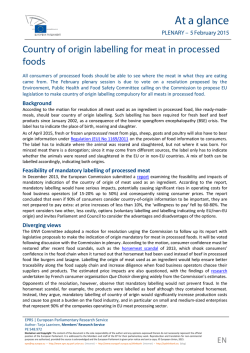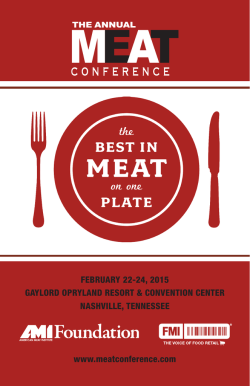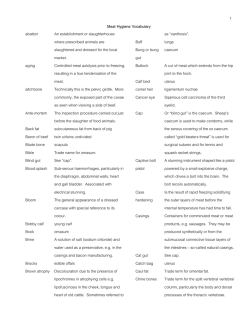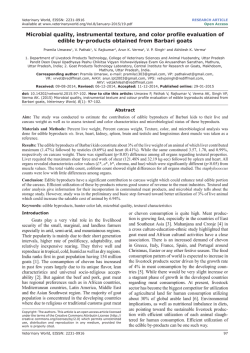
Chapter 23 Meat Cookery
Chapter 23 Meat Cookery Contents Section 23.1 Meat Basics Section 23.2 Meat Cuts Section 23.3 Principles of Cooking Meat Glencoe Culinary Essentials Chapter 23 Meat Cookery 1 Chapter 23 Meat Cookery Section 23.1 Meat Basics • Meat is an essential part of most foodservice operations’ menus. • It is important to know how to purchase and safely store meat. Glencoe Culinary Essentials Chapter 23 Meat Cookery 2 Chapter 23 Meat Cookery Content Vocabulary Academic Vocabulary meat composed marbling reveal fat cap barding larding muscle fibers collagen elastin primal cut fabricated cut carcass yield grade Glencoe Culinary Essentials Chapter 23 Meat Cookery 3 Chapter 23 Meat Cookery Structure of Meat • Meat is an essential part of many people’s diets and of most foodservice operations’ menus. meat The muscle of animals, such as cattle and hogs. • Meat muscle has: • 75% water • 20% protein • 5% fat Glencoe Culinary Essentials Chapter 23 Meat Cookery 4 Chapter 23 Meat Cookery Structure of Meat • Two types of fat in meat: • marbling – affects meat tenderness, taste, and quality • fat cap – keeps meat moist and juicy marbling fat cap Fat within the muscle tissue. The fat that surrounds muscle tissue. Glencoe Culinary Essentials Chapter 23 Meat Cookery 5 Chapter 23 Meat Cookery Structure of Meat • Meat products have three components: • muscle fibers • connective tissue • bones muscle fibers Fiber in meat that determines the meat’s texture and contribute to its flavor. Glencoe Culinary Essentials Chapter 23 Meat Cookery 6 Chapter 23 Meat Cookery Structure of Meat Describe each type of meat cut. Meat Cut Description Primal Cut Sometimes called a wholesale cut; a large, primary piece of meat separated from the animal Fabricated Cut A smaller, menu-size portion taken from a primal cut Whole Carcass What is left of the animal after it has been slaughtered; does not usually include the head, feet, or hide Glencoe Culinary Essentials Chapter 23 Meat Cookery 7 Chapter 23 Meat Cookery Purchasing Meats • Consider the menu, the cooking method, and the price when purchasing meat. • Meat for all foodservice operations must have a USDA Inspect Stamp, which reveals if the meat is fit for human consumption. Glencoe Culinary Essentials Chapter 23 Meat Cookery 8 Chapter 23 Meat Cookery Purchasing Meats • USDA Meat Grades: • Prime – best grade; most expensive; must have excellent marbling and a thick fat cap • Choice – more widely accepted in foodservice industry; great value • Select – has very little marbling; used for cost-effectiveness Glencoe Culinary Essentials Chapter 23 Meat Cookery 9 Chapter 23 Meat Cookery Purchasing Meats • USDA Yield Grades: • Yield Grade I (lowest) through Yield Grade 5 (highest) yield grade Measures the amount of usable meat on beef and lamb. Glencoe Culinary Essentials Chapter 23 Meat Cookery 10 Chapter 23 Meat Cookery Purchasing Meats • To store fresh meat: Place it in the refrigerator at 41ºF (5ºC) or below on trays so juices do not contaminate other foods. • To freeze fresh meat: Place it in the freezer at 0ºF (-18ºC) or below wrapped in airtight, moisture-proof packaging. What meat dishes have you tried? Glencoe Culinary Essentials Chapter 23 Meat Cookery 11 Chapter 23 Meat Cookery Section 22.2 Meat Cuts • Before being shipped, meat is divided into primal cuts. • Primal cuts are then further divided into fabricated cuts before they are prepared. Glencoe Culinary Essentials Chapter 23 Meat Cookery 12 Chapter 23 Meat Cookery Content Vocabulary Academic Vocabulary pork portion processing resist curing lamb mutton veal Glencoe Culinary Essentials Chapter 23 Meat Cookery 13 Chapter 23 Meat Cookery Cuts of Pork • There are five primal pork cuts: • loin • shoulder/butt • spareribs/belly pork • ham The meat from hogs that are less than one year old. Glencoe Culinary Essentials Chapter 23 Meat Cookery 14 Chapter 23 Meat Cookery Cuts of Pork • Most pork is processed, by curing, smoking, or irradiation. • Curing forms include pickle, injection, and sugar. curing Preserving pork with salt, sugar, spices, flavoring, and nitrites. Glencoe Culinary Essentials Chapter 23 Meat Cookery 15 Chapter 23 Meat Cookery Cuts of Lamb • There are five primal lamb cuts: • shoulder • shank/breast • rack • loin • leg Glencoe Culinary Essentials Chapter 23 Meat Cookery 16 Chapter 23 Meat Cookery Cuts of Lamb • Quality lamb should be pink to red, firm, with some marbling in lean areas. • To store fresh lamb: Store for 2 to 5 days in the refrigerator at 41ºF (5ºC). • To freeze fresh lamb: Store for 6 to 9 months in the freezer at 0ºF (-18ºC). Glencoe Culinary Essentials Chapter 23 Meat Cookery 17 Chapter 23 Meat Cookery Cuts of Veal • There are five primal veal cuts: • shoulder • foreshank/breast • rack • loin veal • leg The meat from calves that are less than nine months old. Glencoe Culinary Essentials Chapter 23 Meat Cookery 18 Chapter 23 Meat Cookery Cuts of Beef • There are five primal cuts of beef: • chuck • brisket/plate/flank • rib • loin • round Glencoe Culinary Essentials Chapter 23 Meat Cookery 19 Chapter 23 Meat Cookery Section 23.3 Principles of Cooking Meat • A foodservice employee must fully understand meat cooking techniques. • Meat is expensive and the operation will lose money if it is improperly cooked. Glencoe Culinary Essentials Chapter 23 Meat Cookery 20 Chapter 23 Meat Cookery Content Vocabulary Academic Vocabulary high-heat cooking satisfy low-heat cooking content rest grain spice rub trichinosis rare medium rare medium medium well well done Glencoe Culinary Essentials Chapter 23 Meat Cookery 21 Chapter 23 Meat Cookery Cooking for Tenderness • Because meat is expensive, a foodservice operation must fully understand meat cooking techniques. • The temperature of the heat source has an important effect on how meat cooks and how it will taste. Glencoe Culinary Essentials Chapter 23 Meat Cookery 22 Chapter 23 Meat Cookery Cooking for Tenderness • Roasting Meats: • does not require water or other liquids • chefs sometimes wrap meat with fat to enhance flavor and retain moisture Glencoe Culinary Essentials Chapter 23 Meat Cookery 23 Chapter 23 Meat Cookery Cooking for Tenderness • Roasting Meats: • requires resting the meat and always carving against the grain rest grain To allow cooked meat to sit so that juices redistribute throughout the meat. The direction of muscle fibers, or treads, in meat. Glencoe Culinary Essentials Chapter 23 Meat Cookery 24 Chapter 23 Meat Cookery Cooking for Tenderness • Roasting Meats: • roasting tips: – trim heavy fat covering, leaving a thin layer – season several hours before roasting – season again after cooking is done – season the meat’s juices and serve with the meat Glencoe Culinary Essentials Chapter 23 Meat Cookery 25 Chapter 23 Meat Cookery Cooking for Tenderness • Broiling and Grilling Meats: • use high heat and fast cooking times • barbequing uses slow cooking times and low heat Glencoe Culinary Essentials Chapter 23 Meat Cookery 26 Chapter 23 Meat Cookery Cooking for Tenderness • Broiling and Grilling Meats: • broiling and grilling tips: – shorter cooking times need higher heat – thicker meat cuts need longer cooking times – set grill controls for different temperatures – vary cooking temperatures by moving meat across the grill – use high heat for a crispy surface – create cross-hatch grill marks Glencoe Culinary Essentials Chapter 23 Meat Cookery 27 Chapter 23 Meat Cookery Cooking for Tenderness • Sautéing or Pan-Frying Meat: • usually used for thin cuts of meat • meats that contain bones or breaded meats are usually pan fried What are the differences between sautéing and pan-frying? Glencoe Culinary Essentials Chapter 23 Meat Cookery 28 Chapter 23 Meat Cookery Cooking for Tenderness • Sautéing and Pan-Frying Meats: • sautéing and pan-frying tips: – use the right amount of oil – never overcrowd the pan – turn or move meat as little as possible – do not use unclarified butter, as it burns easily Glencoe Culinary Essentials Chapter 23 Meat Cookery 29 Chapter 23 Meat Cookery Cooking for Tenderness • Braising and Stewing Meats: • used for less-tender cuts of meats • are both combination techniques • for stewing, liquid completely covers the meat • the liquid used is important for the flavor of the dish Glencoe Culinary Essentials Chapter 23 Meat Cookery 30 Chapter 23 Meat Cookery Cooking for Tenderness • Braising and Stewing Meats: • braising and stewing tips: – pat the meat dry prior to browning – dredge the meat in flour before cooking to improve browning – do not use more liquid than necessary – meat should be fork-tender when done Glencoe Culinary Essentials Chapter 23 Meat Cookery 31 Chapter 23 Meat Cookery Cooking for Tenderness • Meat’s doneness depends on: • cooking method • size and type of meat • internal temperature • color • the amount of time it has cooked Glencoe Culinary Essentials Chapter 23 Meat Cookery 32 Chapter 23 Meat Cookery Cooking for Tenderness Describe the different levels of doneness for meat. Meat Doneness Description Rare Browned on the surface with a red center Medium Rare Browned on the surface, thicker gray outer layer, red to slightly pink center Medium Browned on the surface, even thicker gray outer layer, pink center Medium Well Browned on the surface, thick gray outer layer, barely pink center Well Done Browned on the surface, gray inside Glencoe Culinary Essentials Chapter 23 Meat Cookery 33 Chapter 23 Meat Cookery Chapter Summary Section 23.1 Meat Basics • Meats can be purchased in the form of primal cuts or fabricated cuts. Glencoe Culinary Essentials Chapter 23 Meat Cookery 34 Chapter 23 Meat Cookery Chapter Summary Section 23.2 Meat Cuts • Primal cuts of pork, lamb, veal, and beef are then divided into fabricated cuts for ease of handling and preparation. • To buy the highest quality of pork, lamb, veal, or beef, look for the quality characteristics for each type of meat. Glencoe Culinary Essentials Chapter 23 Meat Cookery 35 Chapter 23 Meat Cookery Chapter Summary Section 23.3 Principles of Cooking Meat • • • Using the correct method to cook meat can enhance its flavor and tenderize it. The doneness of meat depends on the cooking method, the type and cut of meat, the internal color and temperature, and the customer’s preferences. Meat may be rare, medium rare, medium, medium well, and well done. Glencoe Culinary Essentials Chapter 23 Meat Cookery 36 Chapter 23 Meat Cookery Review Do you remember the vocabulary terms from this chapter? Use the following slides to check your knowledge of the definitions. The slides in this section include both English and Spanish terms and definitions. Start Glencoe Culinary Essentials Chapter 23 Meat Cookery 37 Chapter 23 Meat Cookery meat carne The muscle of animals, such as cattle and hogs. El músculo de animales, como ganado y cerdos. Show Definition Glencoe Culinary Essentials Chapter 23 Meat Cookery 38 Chapter 23 Meat Cookery marbling marmoleo Fat within the muscle tissue. Grasa en el tejido muscular. Show Definition Glencoe Culinary Essentials Chapter 23 Meat Cookery 39 Chapter 23 Meat Cookery fat cap capa de grasa The fat that surrounds muscle tissue. La grasa que rodea el tejido muscular. Show Definition Glencoe Culinary Essentials Chapter 23 Meat Cookery 40 Chapter 23 Meat Cookery barding albardar Wrapping a lean meat with fat, such as bacon, before roasting. A few minutes before doneness, you remove the meat from the oven, unwrap the fat, put the meat back in the oven, and allow the surface of the meat to brown. Se envuelve un pedazo de carne en grasa, como tocino, antes de asar. Unos minutos antes de que la carne esté cocida se saca del horno, se le quita la capa de grasa, y se vuelve a meter al horno para que la superficie se dore. Show Definition Glencoe Culinary Essentials Chapter 23 Meat Cookery 41 Chapter 23 Meat Cookery larding mechar Inserting long, thin strips of fat or vegetables into the center of lean meat. Insertar tiras largas y delgadas de grasa o verduras entre de la carne. Show Definition Glencoe Culinary Essentials Chapter 23 Meat Cookery 42 Chapter 23 Meat Cookery muscle fibers fibras musculares Fiber in meat that determines the meat’s texture and contribute to its flavor. Las fibras de la carne que determinan su textura y contribuyen a su sabor. Show Definition Glencoe Culinary Essentials Chapter 23 Meat Cookery 43 Chapter 23 Meat Cookery collagen colágeno Soft, white tissue that breaks down into gelatin and water during slow, moist cooking processes. Suave tejido blanco que se deshace en gelatina y agua durante el lento proceso de cocción. Show Definition Glencoe Culinary Essentials Chapter 23 Meat Cookery 44 Chapter 23 Meat Cookery elastin elastina A hard, yellow tissue that does not break down during cooking. Also referred to as gristle. Un tejido duro de color amarillo que no se descompone durante la cocción. También se llama cartílago. Show Definition Glencoe Culinary Essentials Chapter 23 Meat Cookery 45 Chapter 23 Meat Cookery primal cut corte primario Sometimes called wholesale cuts, large, primary pieces of meat separated from the animal. A veces llamado cortes al mayor, grandes trozos de carne separadas de los animales. Show Definition Glencoe Culinary Essentials Chapter 23 Meat Cookery 46 Chapter 23 Meat Cookery fabricated cut pequeño corte de carne A smaller portion of meat taken from primal cuts. Porción pequeña de carne tomada de un pedazo más grande. Show Definition Glencoe Culinary Essentials Chapter 23 Meat Cookery 47 Chapter 23 Meat Cookery carcass restos de animal What is left of the whole animal after it has been slaughtered. Lo que queda de todo el animal después de matarlo. Show Definition Glencoe Culinary Essentials Chapter 23 Meat Cookery 48 Chapter 23 Meat Cookery yield grade empacado al vacío Measures the amount of usable meat on beef and lamb. rendimiento cárnico. Show Definition Glencoe Culinary Essentials Chapter 23 Meat Cookery 49 Chapter 23 Meat Cookery pork carne de cerdo The meat from hogs that are less than 1 year old. La carne de cerdos menores de 1 año. Show Definition Glencoe Culinary Essentials Chapter 23 Meat Cookery 50 Chapter 23 Meat Cookery processing procesamiento The act of changing meat by artificial means. El acto de cambiar la carne por medios artificiales. Show Definition Glencoe Culinary Essentials Chapter 23 Meat Cookery 51 Chapter 23 Meat Cookery curing curado Preserving pork with salt, sugar, spices, flavoring, and nitrites. La preservación de la carne de cerdo con sal, azúcar, especias, aromas y nitritos. Show Definition Glencoe Culinary Essentials Chapter 23 Meat Cookery 52 Chapter 23 Meat Cookery lamb borrego (cordero) Meat that comes from sheep that are less than 1 year old. Carne de oveja de menos de 1 año. Show Definition Glencoe Culinary Essentials Chapter 23 Meat Cookery 53 Chapter 23 Meat Cookery mutton cordero Meat from sheep older than 1 year. La carne de ovejas de más de 1 año. Show Definition Glencoe Culinary Essentials Chapter 23 Meat Cookery 54 Chapter 23 Meat Cookery veal ternera The meat from calves that are less than nine months old. La carne de terneros que tienen menos de nueve meses. Show Definition Glencoe Culinary Essentials Chapter 23 Meat Cookery 55 Chapter 23 Meat Cookery high-heat cooking cocción a alta temperatura Cooking methods such as broiling and grilling used for tender cuts of meat like tenderloins and strip steaks. Métodos de cocción como asar a la parrilla en el horno o en el asador que se usan para los trozos de carne tierna, como los filetes y tiras de bistec. Show Definition Glencoe Culinary Essentials Chapter 23 Meat Cookery 56 Chapter 23 Meat Cookery low-heat cooking cocinar a baja temperatura The best method for preparing large cuts of meat, such as top round. El mejor método para preparar piezas grandes de carne como la punta trasera. Show Definition Glencoe Culinary Essentials Chapter 23 Meat Cookery 57 Chapter 23 Meat Cookery rest reposar To allow cooked meat to sit so that juices redistribute throughout the meat. Permitir que la carne cocida repose con el fin de que los jugos se redistribuyan por toda la carne. Show Definition Glencoe Culinary Essentials Chapter 23 Meat Cookery 58 Chapter 23 Meat Cookery grain grano The direction of muscle fibers, or treads, in meat. La dirección de las fibras musculares en la carne. Show Definition Glencoe Culinary Essentials Chapter 23 Meat Cookery 59 Chapter 23 Meat Cookery spice rub especies para marinar A mixture of ground spices that is rubbed on raw food before it is cooked. Una mezcla de especias molidas que se frota sobre los alimentos crudos antes de ser cocinados. Show Definition Glencoe Culinary Essentials Chapter 23 Meat Cookery 60 Chapter 23 Meat Cookery trichinosis triquinosis An infestation by a parasite that can cause muscular pain, stomach upset, fever, weakness, and swelling. Una infección por un parásito que puede causar dolor muscular, malestar estomacal, fiebre, debilidad e hinchazón. Show Definition Glencoe Culinary Essentials Chapter 23 Meat Cookery 61 Chapter 23 Meat Cookery rare término crudo Meat that is browned on the surface, with a red center. Dorar la carne en la superficie, dejando el centro de color rojo. Show Definition Glencoe Culinary Essentials Chapter 23 Meat Cookery 62 Chapter 23 Meat Cookery medium rare término medio crudo Meat that is browned on the surface with a thicker outer layer of gray and a red to slightly pink center. Carne que se dora hasta obtener una capa gruesa de color gris y un color rojo o ligeramente rosado en el centro. Show Definition Glencoe Culinary Essentials Chapter 23 Meat Cookery 63 Chapter 23 Meat Cookery medium término medio Meat that is browned on the surface with a thick outer layer of gray and a pink center. Carne que se dora hasta obtener una capa gruesa de color gris en el exterior y un color rosado en el centro. Show Definition Glencoe Culinary Essentials Chapter 23 Meat Cookery 64 Chapter 23 Meat Cookery medium well término medio a bien cocido Meat that is browned on the surface with a thick outer layer of gray and a center that is barely pink. Carne qu se dora hasta obtener una capa gruesa de color gris y un color apenas rosado en el centro. Show Definition Glencoe Culinary Essentials Chapter 23 Meat Cookery 65 Chapter 23 Meat Cookery well done término bien cocido Browned on the surface and gray on the inside. Que queda dorado en la superficie y gris en el centro. Show Definition Glencoe Culinary Essentials Chapter 23 Meat Cookery 66 Chapter 23 Meat Cookery composed compuesto Made up of. Hecho de. Show Definition Glencoe Culinary Essentials Chapter 23 Meat Cookery 67 Chapter 23 Meat Cookery reveal revelar To make known. Dar a conocer. Show Definition Glencoe Culinary Essentials Chapter 23 Meat Cookery 68 Chapter 23 Meat Cookery portion ración Part. Parte. Show Definition Glencoe Culinary Essentials Chapter 23 Meat Cookery 69 Chapter 23 Meat Cookery resist resistir To avoid. Evitar. Show Definition Glencoe Culinary Essentials Chapter 23 Meat Cookery 70 Chapter 23 Meat Cookery satisfy satisfacer To fill. Llenar. Show Definition Glencoe Culinary Essentials Chapter 23 Meat Cookery 71 Chapter 23 Meat Cookery content contenido Amount. Cantidad. Show Definition Glencoe Culinary Essentials Chapter 23 Meat Cookery 72 End of Chapter 23 Meat Cookery
© Copyright 2026





